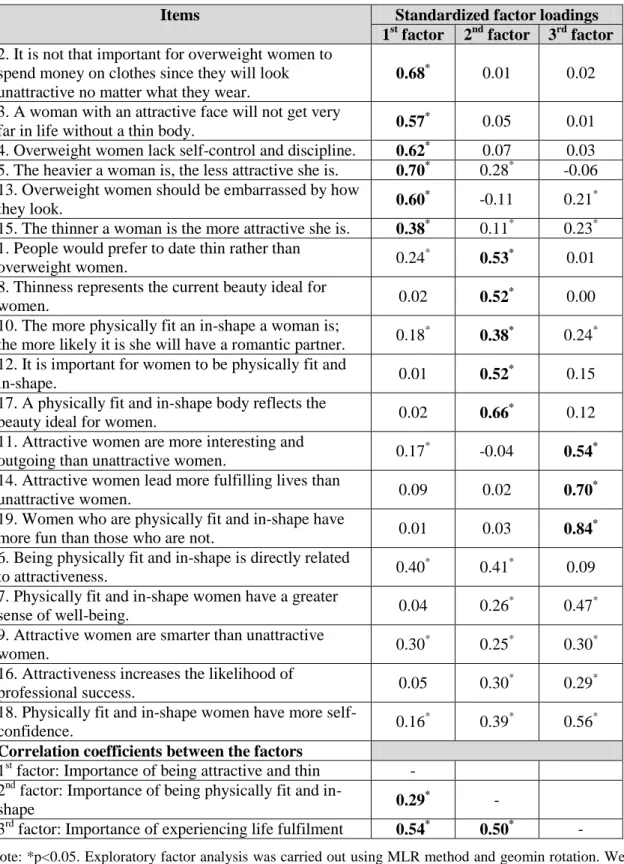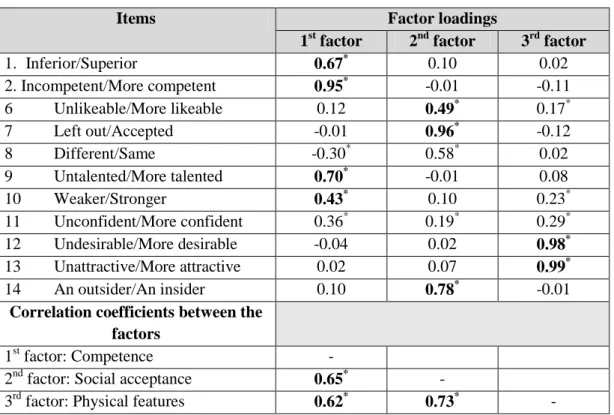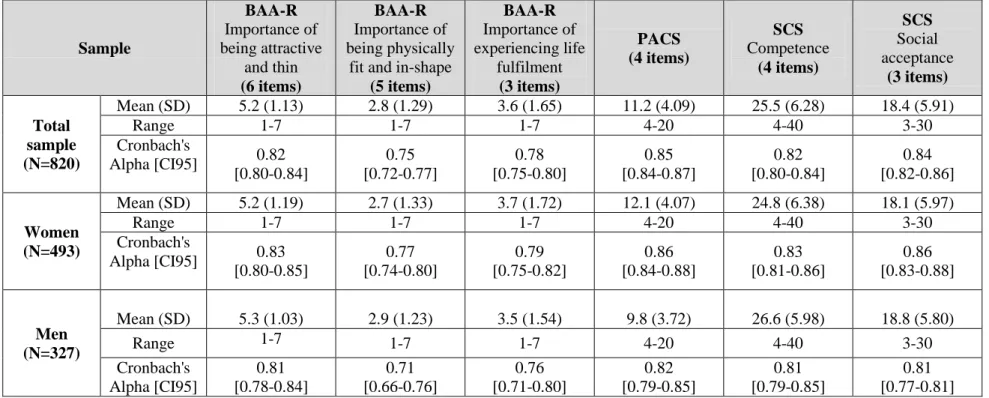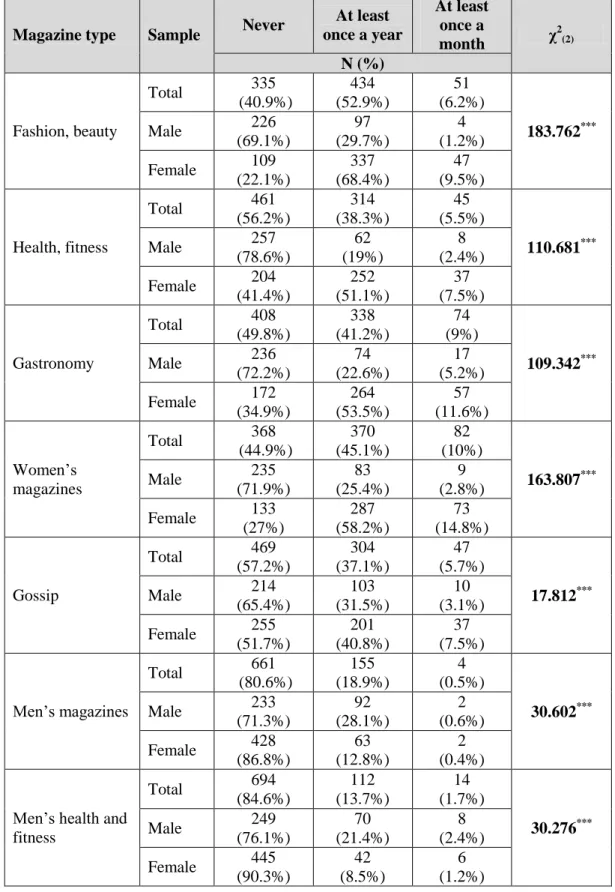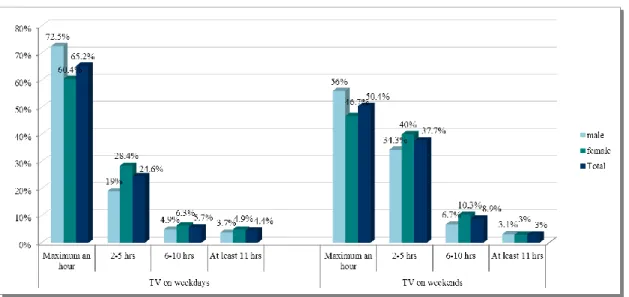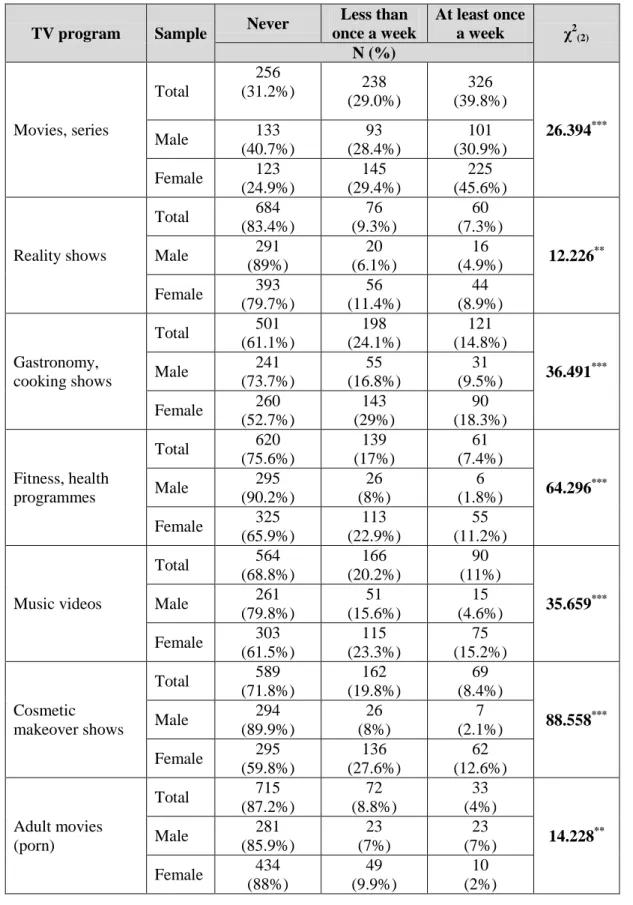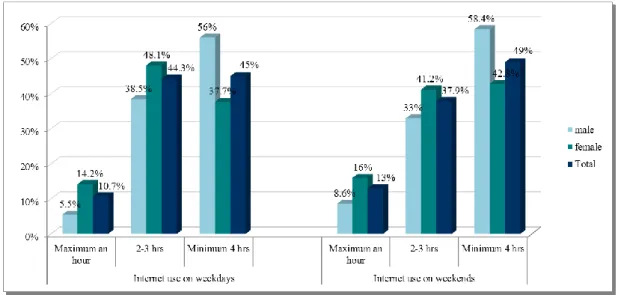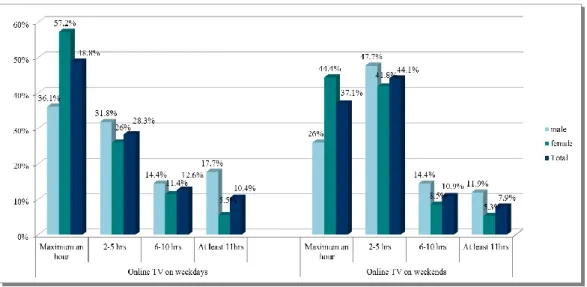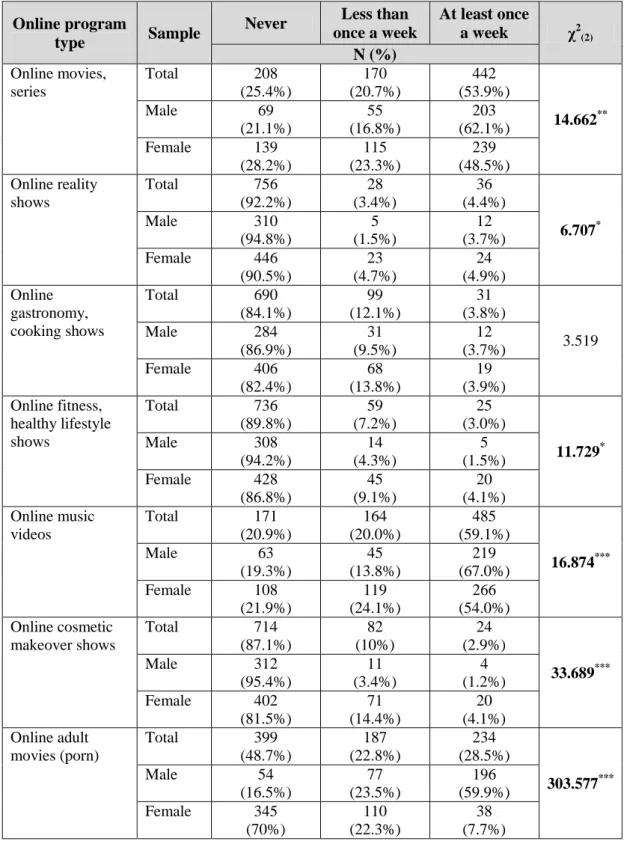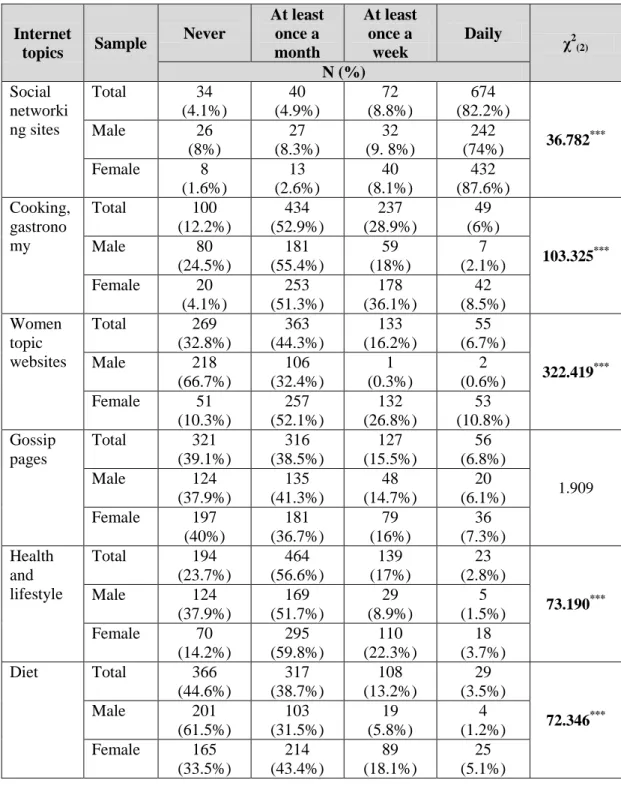Sociocultural aspects of eating disorders
The potential interaction between media exposure and eating disorders related symptomatology
Ph.D. thesis
Kornélia Szabó
Mental Health Sciences Doctoral School
Semmelweis University, Institute of Behavioural Sciences
Supervisor: Irena Szumska, Ph.D.
Official reviewers: Szabolcs Török, M.D., Ph.D.
Katalin Barabás M.D., Ph.D.
Head of the Final Examination Committee:
László Tringer, M.D., Ph.D., C.Sc.
Members of the Final Examination Committee:
Lajos Simon, M.D., Ph.D., C.Sc.
Zsolt Demetrovics, Ph.D., D.Sc.
Budapest, 2016
TABLE OF CONTENTS
1. LIST OF ABBREVIATIONS... 6
2. INTRODUCTION ... 8
2.1 Preamble ... 8
2.2 Epidemiology of eating disorders ... 9
2.3 Body Image ... 11
2.4 Thin-ideal internalization ... 12
2.5 Social and appearance comparisons ... 13
2.6 Media and risk of eating disorders ... 15
2.6.1 Magazines and risk of eating disorders ... 16
2.6.2 Television and risk of eating disorders ... 18
2.6.2.1 Music videos ... 19
2.6.2.2 Cosmetic makeover shows ... 20
2.6.3 The Internet and the risk of eating disorders ... 21
2.6.3.1 Social Networking sites ... 22
2.6.3.2 Eating disorders promoting websites ... 23
2.6.4 Dieting and weight loss information in the media ... 24
2.6.5 Pornographic content ... 25
2.7 Social psychology theories ... 26
2.8 Anthropometric characteristics of idealized bodies in the media ... 27
2.9 The role of the culture ... 30
3 OBJECTIVES ... 33
3.1 General objectives of the study ... 33
3.2 Questionnaire validation and adaptation ... 33
3.3 Psychological correlates regarding various media exposure... 34
3.4 Seeking weight loss information and the use of weight-reduction methods 35 3.5 Predictors of body dissatisfaction and drive for thinness ... 35
3.6 Predictors of risk for developing eating disorders ... 35
4 METHODS ... 37
4.1 Participants ... 37
4.2 Data collection procedures ... 37
4.2.1 Dissemination ... 37
4.2.2 Online data collection ... 39
4.3 Measures... 41
4.3.1 Media exposure ... 41
4.3.1.1 Magazines ... 41
4.3.1.2 Television ... 42
4.3.1.3 Internet ... 42
4.3.1.4 Online Television programmes ... 43
4.3.2 Questionnaires ... 43
4.3.2.1 The Eating Disorder Inventory ... 43
4.3.2.2 The SCOFF questionnaire ... 44
4.3.2.3 The Short Evaluation of Eating Disorders questionnaire ... 44
4.3.2.4 The Sociocultural Attitudes Towards Appearance Questionnaire ... 45
4.3.2.5 The Rosenberg Self-esteem Scale ... 45
4.3.2.6 Beliefs About Attractiveness Scale-Revised ... 46
4.3.2.7 The Physical Appearance Comparison Scale ... 46
4.3.2.8 The Social Comparison Scale ... 47
4.3.2.9 Dieting habits ... 47
4.4 Statistical Analyses ... 48
5 RESULTS ... 49
5.1 Psychometric properties of the questionnaires ... 49
5.1.1 Psychometric analysis of the Beliefs About Attractiveness – Revised questionnaire ... 49
5.1.2 Psychometric analysis of the Physical Appearance Comparison Scale ... 51
5.1.3 Psychometric analysis of the Social Comparison Scale ... 51
5.2 Descriptive statistics ... 54
5.2.1 Media exposure ... 54
5.2.2 Magazine reading ... 54
5.2.3 Television watching ... 56
5.2.4 Internet use ... 59
5.2.5 Online television watching ... 59
5.2.6 Online topics ... 62
5.2.7 Social media exposure ... 64
5.3 Psychological variables ... 65
5.4 Media consumption correlates ... 70
5.4.1 Magazine reading ... 70
5.4.2 Television programmes ... 73
5.4.3 Internet topics ... 75
5.4.4 Online television programmes ... 78
5.5 Weight loss related information in the media ... 80
5.5.1 Associations between media exposure to weigh loss content and weight reduction methods ... 85
5.6 Multivariate predictors of drive for thinness ... 88
5.7 Predictors of risk for developing an eating disorder ... 95
6. DISCUSSION ... 102
6.1 Adaptation of three questionnaires in Hungary... 103
6.1.1 Adaptation of the Beliefs About Attractiveness Scale– Revised questionnaire in Hungary ... 103
6.1.2 Adaptation of the Physical Appearance Comparison Scale in Hungary 103 6.1.3 Adaptation of the Social Comparison Scale in Hungary ... 104
6.2 Media exposure and psychological correlates ... 106
6.2.1 Magazines ... 108
6.2.2 Television ... 110
6.2.3 Internet ... 111
6.3 Seeking weight loss information on the Internet and in magazines and weight reduction techniques in a Hungarian sample ... 113
6.4 Multivariate predictors of drive for thinness ... 115
6.5 Predictors for being at risk for EDs in regards to visiting diet, fitness and ProED websites ... 119
6.6 Limitations ... 122
7. CONCLUSIONS ... 125
8. SUMMARY ... 127
9. ÖSSZEFOGLALÁS ... 128
10. BIBLIOGRAPHY ... 129
11. BIBLIOGRAPHY OF THE CANDIDATE‘S PUBLICATIONS ... 160
11.1 PEER-REVIEWED ARTICLES ... 160
11.2 BOOK CHAPTERS ... 160
12. ACKNOWLEDGEMENTS ... 161
13. LIST OF TABLES ... 163
14. LIST OF FIGURES ... 165
15. APPENDIX ... 166
15.1 Questionnaires used in the current study... 166
15.1.1 Médiafogyasztás kérdőív (Media exposure questionnaire) ... 166
15.1.2 Diétázási szokásokkal kapcsolatos kérdéssor ... 168
15.1.3 Evési Zavar Kérdőív (Eating Disorder Inventory, EDI)... 169
15.1.4 SCOFF kérdőív (SCOFF questionnaire) ... 171
15.1.5 The Short Evaluation of Eating Disorders questionnaire ... 171
15.1.6 A Megjelenéssel Kapcsolatos Szociokulturális Attitűdök Kérdőív (The Sociocultural Attitudes Towards Appearance Questionnaire, SATAQ-3) ... 173
15.1.7 A Vonzóságról Alkotott Hiedelmek Skála módosított változata (Beliefs About Attractiveness – Revised, BAA-R) ... 174
15.1.8 Rosenberg Önértékelés Skála (The Rosenberg Self-esteem Scale, RSE) .... ... 175
15.1.9 A Fizikai Megjelenéssel Kapcsolatos Összehasonlítás Skála (The Physical Appearance Comparison Scale, PACS) ... 175 15.1.10 Társas Összehasonlítás Skála (The Social Comparison Scale, SCS) . 176
1. LIST OF ABBREVIATIONS
AN anorexia nervosa
BAA-R beliefs about attractiveness scale-revised
BED binge eating disorder
BMI body mass index
BN bulimia nervosa
CFA confirmative factor analysis
CFI comparative fit index
ED eating disorder
EDI eating disorder inventory
EDNOS eating disorder not otherwise specified EFA explorative factor analysis
MIMIC multiple indicators and multiple causes analysis OSFED other specified feeding or eating disorder PACS physical appearance comparison scale ProED eating disorder supporting (websites) RMSEA root mean square error of approximation
RSE Rosenberg self-esteem scale
SATAQ-3 sociocultural attitudes towards appearance questionnaire
SCS social comparison scale
SEED short evaluation of eating disorders SEM structural equation modelling
SRMR standardized root mean square residual UFED unspecified feeding and eating disorder
D
ECLARATIONThis work has not been submitted previously for a degree, diploma, or Ph.D. thesis in any university. To best of my knowledge and belief, this thesis contains no material previously published or written by another person except where due reference is made in the thesis itself. The data for this research were collected and analysed by the principal researcher.
__________________________________
June 2016 Budapest
2. I
NTRODUCTION“It’s difficult to be healthy in what I call a ʻtoxic cultural environmentʼ – an environment that surrounds us with unhealthy images and constantly sacrifices our health and our sense of wellbeing for the sake of profit.”
/Jean Kilbourne, 2012
2.1 Preamble
In recent years, more and more studies have emerged to investigate the contributing background factors to the development and maintenance of eating disorders (EDs). Not just thousands of journal articles but also many books and chapters tried to specify the possible causes of EDs. The ―biopsychosocial‖ model is a consensual approach, which integrates various contributing factors. There is no single cause of EDs. The biopsychosocial model suggests that there are complex interactions between social, environmental, psychological, and biological factors (Polivy & Herman, 2002; Sigman
& Flanery, 1992). Among background factors, sociocultural factors play a considerable role in the development of body-image dissatisfaction, which is one of the most important risk factors that might lead to EDs. In Western societies, a great emphasis is placed on shape, weight and more generally on physical appearance. The sociocultural factors manifest on different levels and influence body weight regulation indirectly.
The occurrence of EDs is not uniform across cultures and times. It is concentrated in cultures where an abundance of food is available and an obsession with slimness – core characteristic of EDs – can be observed. However, this cause is not specific, because most people in even the wealthiest cultures do not develop EDs (Polivy & Herman, 2002). Despite the fact that EDs have previously been described as culture-bound illnesses, and are most common among white Western women, (Keel & Klump, 2003), previous studies show that disordered eating and EDs do occur in both non-Western countries and also among ethnic minorities in Western countries.(Eddy, Hennessey, &
Thompson-Brenner, 2007; Marques et al., 2011). Although cultures may value slimness, there are individual differences as to what extent people internalize the importance and value of slimness. The extent of internalization can predict body dissatisfaction, drive for thinness, and some bulimic characteristics (Stice 2001). We can see that as our
culture becomes more and more homogenized, with widespread media images of an idealized thin body, EDs have become accordingly more common as well (Striegel- Moore, 1997).
It is known that mass media have utmost importance in shaping values and norms (e.g. Becker & Hamburg, 1996; Harrison & Cantor, 1997; Levine & Murnen, 2015;
Slater & Tiggemann, 2014; Túry & Pászthy, 2008). Media as a concept is used in this study in the meaning of mass media which refers collectively to all media technologies that are used for most mass information distribution, including magazines, television, and the Internet. The contemporary ‗slim body ideal‘, popular diets, and other appearance-related contents and expectations often reach people through the media. It is often said that mass media are one of the many reasons for the increasing incidence of EDs, mainly based on the grounds that media images of slender bodies motivate or even force people to try to achieve this slimness (Polivy & Herman, 2002).
The lack of studies aiming to investigate the effects of mass media on body image disordered eating and EDs related symptomatology in Hungary has influenced this study to explore this specific field. Although there are numerous important Hungarian studies depicting the growing tendency of the slimness culture and the popularization of such unrealistic ideals (Forgács, 2008; Forgács, 2010; Forgács & Németh, 2008), only a few studies investigated the effects of media on EDs in the Hungarian population (Papp, Czeglédi, Túry, 2011; Szabó, Túry, & Czeglédi, 2011; Török & Pászthy, 2008).
Although approximately 90% of ED sufferers are women (Kashubeck-West & Mintz, 2001), men are also affected by EDs (van Hoeken, Seidell, & Hoek, 2003).
Sociocultural influences affect men to a similar extent as they affect women, although the underlying variables might differ (e.g. Daniel & Bridges, 2010; Duggan &
McCreary, 2004). Among men, EDs are different in nature, with men seeking help less often than women do (Braun, Sunday, Huang, & Halmi, 1999).
2.2 Epidemiology of eating disorders
Although EDs are considered relatively rare among the general population, the occurrence of these disorders has been continuously increasing in recent years (Smink, van Hoeken, & Hoek, 2012). These elevated rates could be due to improvements in case detection, a general increase in public awareness, which in turn can result in earlier
detection, and finally the wider availability of treatment services could influence these numbers (Hoek & Van Hoeken, 2003; van Son, van Hoeken, Bartelds, van Furth, &
Hoek, 2006). The most often discussed EDs are anorexia nervosa (AN), bulimia nervosa (BN), binge eating disorder (BED) and unspecified feeding and eating disorders (UFED). According to Hoek and Van Hoeken‘s report (2003), they found an average prevalence rate for anorexia nervosa of 0.3% among young females. Regarding bulimia nervosa, the prevalence rates were 1% and 0.1% among young women and young men, respectively. In the case of binge eating disorder, the estimated prevalence was at least 1%. Furthermore, the incidence of anorexia nervosa was found to be eight cases per 100,000 population per year and the incidence of bulimia nervosa was found to be 12 cases per 100,000 population per year.
Most of the time EDs are described as the disorders of the ―3W‖ (white Western women) and characterized as culture-bound syndromes (Prince, 1985). The first epidemiology studies in the field of EDs were also carried out in Western countries (e.g.
Russell, 1979). However, as other studies have shown, the prevalence rates of EDs are similar in other, non-Western countries as well (e.g. Makino, Tsuboi, & Dennerstein, 2004; Preti et al., 2009). In a representative Hungarian study, the following point prevalence rates were found: 0.03% for of AN, 0.41% for BN, 1.09% for subclinical AN, 1.48% for subclinical BN (Szumska, Túry, Csoboth, Réthelyi, Purebl, & Hajnal, 2005). At the moment, the biggest category of EDs is those that cannot be clearly classified - previously known as eating disorder not otherwise specified (EDNOS) -, these are now referred to as Other Specified Feeding or Eating Disorder (OSFED) and Unspecified Feeding or Eating Disorder (UFED) in DSM-V (American Psychiatric Association, 2013). The prevalence rate of EDNOS among 12–18-year-old Spanish students was reported to be 4.71% among girls, and 0.77% among boys (Rojo et al., 2003). An Australian study also reported a 5.3% prevalence lifetime rate for purging disorder (Wade, Bergin, Tiggemann, Bulik, & Fairburn, 2006). In addition, Szumska, Túry, and Szabó (2008) emphasize in their report that prevalence rates are similar to the European prevalence rates in Hungary as well.
2.3 Body Image
Body image is described as a multidimensional concept, having cognitive, affective, and behavioural aspects (Wertheim, Paxton, & Blaney, 2009). In previous years, many studies focused on various factors that are associated with eating disorders (EDs) and body image disturbance (Field, Camargo, Taylor, Berkey, Roberts, & Colditz, 2001;
Stice, Marti & Durant, 2011; Thompson, Heinberg, Altabe, & Tantleff-Dunn, 1999;
Thompson & Smolak, 2001).
Body shape concerns and weight dissatisfaction among women and girls is widespread and numerous studies reported that being dissatisfied with someone‘s weight or shape among women is described as ―a normative discontent‖ (Rodin, Silberstein, & Striegel-Moore, 1984; Tantleff-Dunn, Barnes, & Larose, 2011;
Thompson & Smolak, 2001). Furthermore, another report described body image and muscle dissatisfaction as ‗normative‘ for men as well (Tiggemann, Martins, &
Kirkbride, 2007). It is also well known that body dissatisfaction alone represents a risk factor for clinical eating disorders (Stice 2002). Body image has been claimed to be the strongest predictor for disordered eating and eating disorder symptomatology (Mazzeo, 1999). As we mentioned, body image is a complex construct, shaped by multiple elements during the years from early childhood to late adulthood (Thompson & Smolak, 2001). It is shown that body image problems among adolescent and adult females are associated with the use of weight control techniques, including diets and compulsive exercise. These can have consequences, including a greater risk for the development of eating disorders and obesity later on (Stice, Cameron, Killen, Hayward, &Taylor, 1999;
Stice, 2001; Neumark-Sztainer, Wall, Guo, Story, Haines, & Eisenberg, 2006). Body image problems are also associated with low self-esteem, impaired psychological functioning and depression (Stice, Hayward, Cameron, Killen, & Taylor, 2000;
Tiggemann, 2005).
Many different factors contribute to body image problems including biological factors; however, these are not directly related. Weight, shape, and BMI have a strong genetic basis. It has been argued that BMI as an indirect biological contributor represents a risk factor for later body dissatisfaction through social-psychological pathways (Thompson & Smolak, 2001). One of these pathways is represented by the sociocultural influences that encompass our everyday lives. Culture and society play a
major role in the construction, definition and therefore in the development of body image through gender, ethnicity, cross-cultural, historical and age differences (Mensinger, Bonifazi, & LaRosa, 2007; Smolak & Striegel-Moore, 2001).
Nowadays media, peers, and parents (Shroff & Thompson, 2006) represent the strongest sociocultural influences in our lives. Parental comments and criticism regarding their children‘s weight and shape can encourage children to seek weight reduction methods regardless of gender, culture, skin colour, or ethnicity (Haworth &
Hoeppner, 2000; Striegel-Moore & Kearney-Cooke, 1994). These parental comments play an important role in the development of body image. Previous research found significant associations between parental talk, encouragement, and comments regarding their children‘s body or weight and their children‘s weight loss seeking behaviour, body image, and eating disorders (Bauer, Bucchianeri, & Neumark-Sztainer, 2013; Smolak, Levine, & Schermer, 1999).
Problematic peer relationships and social comparison also appear as a risk factor for body-image issues, especially during adolescent years (Helfert & Warschburger, 2011).
Teasing about weight and shape can particularly influence body-esteem (Frisén, Berne,
& Lunde, 2014); can lead to body dissatisfaction in adolescents (Greenleaf, Petrie, &
Martin, 2014) and in adults as well (Quick, Eisenberg, Bucchianeri, & Neumark- Sztainer, 2013). Mass media plays a crucially important role in shaping values and norms especially with regards to body shape, body ideal and appears to act as a risk factor for EDs and related symptomatology (Levine &Murnen, 2015).
2.4 Thin-ideal internalization
Thin-ideal media images negatively affect body satisfaction among women (e.g.
Homan, McHugh, Wells, Watson, & King 2012). The effects of mass media exposure can be argued, as some research supports the notion that the effects are small to moderate and often misinterpreted, and may even be influenced by the media source (e.g. print media, television, Internet) (Ferguson, Winegard, & Winegard, 2011; Grabe, Ward, & Hyde, 2008; Holstrom, 2004). The difference in the influence of mass media exposure only points out the fact that not every individual is negatively affected by mass media exposure. The real problem seems to originate from being susceptible to media images and therefore, those who view these images might internalize them
(Engeln-Maddox, 2005; Giles & Close, 2008). Internalization is used in the meaning of embedding societal ideas concerning attractiveness and appearance and experiencing them as the individual‘s own attitudes and beliefs. It is a process where the individual embraces these ideals of body figures as their own goals to achieve, such as the thin body ideal for women and the athletic body ideal for men (Jones, 2004; Thompson, Heinberg, Altabe, & Tantleff-Dunn, 1999).
Internalization is one of the most powerful risk factors for body dissatisfaction, disordered eating and eating disorders (e.g. Cafri, Yamamiya, Brannick, & Thompson, 2005; Thompson & Stice, 2001). Many theories proposed that internalization has a causal role in the development of body image problems and their consequences. The three most often cited sociocultural theories in this regard are Stice‘s dual-pathway model (Stice, 1994), the Tripartite Influence Model (Thompson et al., 1999) and the objectification theory (Fredrickson & Roberts, 1997; Moradi & Huang, 2008).
These theories, as well as empirical research, suggest that internalization plays a direct role in body image establishment among women (e.g. Cafri et al., 2005;
Thompson & Stice, 2001), and among men, too (e.g. Tylka, 2011). The current cultural stereotype of beauty that is mostly associated with the idealized thin body shape for women and the muscular, athletic bodies for men are widely represented and communicated in present-day media across Westernized societies (Levine & Chapman 2011). Due to the powerful media messages promulgating these body ideals, especially with regards to women, girls and women learn how to treat their bodies as objects, and they internalize the societal emphasis on appearance rather than focusing on inner qualities (Fredrickson & Roberts 1997). It has been long demonstrated that this thin ideal is unrealistic, and mostly unattainable via healthy methods (Tiggemann, 2011).
The process of obsession with looks and the internalization of these ―perfect body shapes‖ were observed in girls as young as 3 years old (Dittmar, Halliwell, & Ive, 2006).
2.5 Social and appearance comparisons
Another factor along with body dissatisfaction and ideal body internalization that plays a considerable role in the development of EDs and body image disturbance is social and appearance based comparisons (e.g. Thompson, Coovert, & Stormer, 1999; Tiggemann
& Polivy, 2010). Although these comparisons are not the same constructs, studies tend to use these terms interchangeably at times. As we already mentioned Festinger (1954), proposed that people engage in social and appearance based comparisons to estimate their ranking on various aspects. With regards to body image, our society, especially women, are exposed to a large number of pictures featuring idealized bodies on a regular basis that therefore possibly serve as comparison targets. Most of the time such media exposure (e.g. magazines, TV) is designed to trigger comparisons so they might engage individuals in buying various products in the hope of ameliorating the perceived shortcomings based on these comparisons (Thompson et al., 1999).
Although Festinger‘s theory (1954) seems to explain some of the comparison processes, we have to note that his theory argues that individuals are most likely to make comparisons with similar others. However, women tend to compare themselves to very thin, unrealistic media images just as often as they make comparisons to more relevant comparison targets (Engeln-Maddox, 2005; Strahan, Wilson, Cressman, &
Buote, 2006). The theory also states that people will stop making comparisons (especially upward comparisons) if these comparisons appear to be damaging or unfavourable to their self-image; however we can observe that women often do make these unfavourable appearance-related comparisons (Leahey, Crowther, & Mickelson, 2007) even if it might have destructive consequences (Strahan et al., 2006). The role of social and appearance-based comparison is tentative; many studies report that it has a mediating role in the onset of body image and eating-related disturbances (e.g.
Fitzsimmons-Craft, Bardone-Cone, Bulik, Wonderlich, Crosby, & Engel, 2014; Van den Berg, Thompson, Obremski-Brandon, & Coovert, 2002).
Tiggemann and McGill (2004) found in their study that media exposure to either body part or full body images increased negative mood and body dissatisfaction in women. More importantly, they also found that the frequency of reported social comparisons mediated the effects of image type on mood and body dissatisfaction.
Myers and Crowther (2009) in their meta-analytic study reviewed 156 articles to explore the relationship between social comparison and body dissatisfaction. They found that gender and age play a moderating role in the relationship between social comparison and body dissatisfaction. They also found that for women the relationship between social comparison and body dissatisfaction is stronger than for men. Although
it might seem that men are less affected by social comparison, studies showed that they might have a different comparison target (Karazsia & Crowther, 2008); for instance, they might compare themselves to pictures depicting muscular individuals rather than a slim build as women do (Bergeron & Tylka, 2007). Hargreaves and Tiggemann‘s study (2009) described that the exposure to muscular-ideal television ads among men with high appearance-orientation led to lower muscle satisfaction and physical attractiveness than non-appearance commercials did. Tiggemann and Polivy (2010) reported that response to thin-ideal media images the dimensions on which social comparison happen are very important for women. They found that intelligence based comparisons led to more positive reactions than appearance based comparisons.
Their results support the theory that appearance comparison could be the mechanism by which idealized media images translate into body dissatisfaction. Unfortunately, when disclaimer labels are placed under such pictures (to inform viewers of the efforts they took to produce these images), these do not decrease the effects of media images on body dissatisfaction among women (Tiggemann, Slater, Bury, Hawkins, & Firth, 2013). Moreover, a recent finding suggests that not only traditional media products such as magazines and TV ads but also social media sites have a huge impact on young women‘s body image and mood via social comparison processes (Fardouly, Diedrichs, Vartanian, Halliwell, & 2015).
2.6 Media and risk of eating disorders
The sociocultural theory of EDs (e.g. Thompson et al. 1999) provides a widely accepted general framework for understanding body dissatisfaction and accompanying disordered eating. Based on this it seems that the current beauty ideals for women and men are bolstered and delivered by various sociocultural factors such as family, peers and the media (Keery, van den Berg, & Thompson, 2004; van den Berg Thompson, Obremski- Brandon, & Coovert, 2002, Hogan & Strasburger, 2008). One of the sociocultural influences is mass media, this is commonly accepted as one of the most extensive and powerful influences (Stice 1994; Tiggemann 2002).
These ideals represented in the (printed and online) media are almost impossible to attain by healthy methods (Owen & Laurel-Seller, 2000; Wiseman, Gray, Mosimann, &
Ahrens‘, 1992). According to the literature, repeated exposure to unrealistic media
images and messages can create both direct and indirect pressures to be thin and this poses as a risk factor for body dissatisfaction, body weight concerns and disordered eating behaviours in adolescent girls and young women (Harrison & Cantor, 1997;
López-Guimerà, Levine, Sánchez-Carracedo, & Fauquet, 2010; Stice, Schupak- Neuberg, Shaw, & Stein, 1994). It has been suggested that sociocultural pressures to attain the thin body ideal bolster affective, body image related problems and eating disturbances in young women (Thompson, Heinberg, Altabe, & Tantleff-Dunn, 1999;
Tiggemann, 2011). This sociocultural influence is often described as being multidimensional, consisting of variables such as perceived pressure or information from the media (Levine, Smolak, & Hayden, 1994; Thompson et al., 1999). Levine and colleagues (1994) found that 70% of girls who engaged in reading magazines mentioned them as an important source of information about beauty and fitness.
The reported influence of thinness-promoting ads, and articles about the individual interpretation of ideal body shape, and how to reach these ideals were found to account for a significant variance in drive for thinness, disordered eating, and weight management behaviours among adolescent girls. Another factor that may be accountable for body dissatisfaction is the perceived pressure from the media to attain the slender body ideal (Cafri et al., 2005). Girls, in particular, are reported to experience strong pressure from the mass media to be thin (e.g. Tiggemann, Gardiner, & Slater, 2000) and in some studies, this perceived pressure has been an important predictor of body dissatisfaction for girls (e.g. Stice & Whitenton, 2002).
2.6.1 Magazines and risk of eating disorders
Different theories and research have been conducted on the potential connection between magazine reading and eating disorder symptomatology (e.g. Morry & Staska, 2001), and a set of related variables (e.g. dieting habits, body dissatisfaction, slim body internalization etc.). Studies reported that fashion/beauty and health/fitness/diet magazine reading among females might influence body dissatisfaction (Harrison &
Cantor, 1997; Botta, 2003; Groesz, Levine, & Murnen, 2002; Harper & Tiggemann, 2008), self-esteem (Irving, 1990; Wilcox & Laird, 2000), or might be in connection with more frequent unhealthy weight control and diet behaviours (Thomsen, Weber &
Brown, 2001; van den Berg, Neumark-Sztainer, Hannan, & Haines, 2007; Utter,
Neumark-Sztainer, Wall, & Story, 2003), with thin body internalization (Field, Camargo, Taylor, Berkey, & Colditz, 1999; Cusumano & Thompson, 1997), with appearance comparison (Tiggemann & Miller, 2010) and with the drive for thinness (Tiggemann & Miller, 2010; Harrison & Cantor, 1997).
According to content analyses, the pictorial and written content in printed media show an emerging trend of harmful and unhealthy messages, advertisements regarding eating habits and dieting behaviour, especially in women‘s magazines (e.g. Guillen &
Barr, 1994; Sypeck, Gray, & Ahrens, 2004; Malkin, Wornian, Chrisler, 1999, Szabó &
Túry, 2012). The enormous number of diet and body-centred advertisements in the printed media can be observed in Hungary as well (Forgács & Nemeth, 2008).
Thomsen, McCoy, Gustafson, and Williams (2002) claimed that the reading frequency of beauty and fashion magazines is most strongly predicted by a woman‘s desire for self-improvement. They also reported that anorexic risk could be predicted by the motivation to learn about dieting and weight loss and by the desire to increase one‘s popularity among family and friends. Vaughan and Fouts (2003) found that increase in time spent with magazine reading was associated with an increase in EDs-related symptomatology over time. Content analysis of magazine covers revealed that 78% of the covers of the women's magazines contained a message regarding bodily appearance;
meanwhile, almost none of the covers of the men's magazines did (Malkin, Wornian, &
Chrisler, 1999). They also found that a quarter of the women‘s magazines had conflicting messages about weight loss and dietary habits. The positioning of appearance and weight-related messages often seemed to imply that weight reduction might lead to a better life.
On the other hand, men‘s magazines provided information and focused mainly on entertainment, knowledge, hobbies, and various activities while women‘s magazines highlighted changing one‘s physical appearance to improve one‘s life (Malkin et al., 1999). Although magazine reading might influence body image and related factors, it is important to note the role of processing. It has been reported that when women were asked to process thin ideal images with a social comparison instruction there were more adverse effects on mood and body satisfaction than the control condition (Tiggemann, Polivy, & Hargreaves, 2009). Recently, men are increasingly targeted by advertisements and pictures in men‘s magazines and in health and lifestyle magazines concerning how
to improve their shape, tone their muscles, and change their exercise and diets (Law &
Labre, 2002; Labre, 2005; Túry & Babusa, 2012). Slater and Tiggemann (2014) reported that the consumption of men's magazines among adolescent boys predicted a drive for thinness and a drive for muscularity.
2.6.2 Television and risk of eating disorders
It has been documented a long time ago that television plays an important role in our lives since it is part of our daily living. It shapes norms and values and influences our attitudes and behaviour on many levels (e.g. Gerbner & Gross, 1976; Becker &
Hamburg, 1996). A growing body of literature shows that television exposure has an effect on eating habits (e.g. Becker, Burwell, Herzog, Hamburg, & Gilman, 2002), obesity (e.g. Lumeng, Rahnama, Appugliese, Kaciroti, & Bradley, 2006; Scully, Dixon,
& Wakefield, 2009), internalization of the thin ideal (e.g. Dohnt & Tiggemann, 2006), poor body image (e.g. Botta, 1999) and eating disorder symptomatology (e.g. Becker, 2004).
Another study also supports these findings. Slater and Tiggemann (2006) reported that childhood media exposure significantly predicted later body image concerns in adulthood. It was found that in general, the amount of television watching did not correlate with body dissatisfaction or the drive for thinness; however, the type of TV program did (Tiggemann & Pickering, 1996). Tiggemann and Pickering (1996) found that among adolescent girls, time spent watching soap operas and movies predicted body dissatisfaction and watching music videos predicted drive for thinness. Hargreaves and Tiggemann (2004) argued that being exposed to idealised advertisements lead to increased body dissatisfaction among girls. These commercials also led to a more negative mood and appearance comparison for both girls and boys; however, the effect on body comparison was stronger for girls. They found that those participants who reported an increased investment also reported greater appearance comparison after viewing idealized ads.
A recent study (Eisenberg, Carlson-McGuire, Gollust, & Neumark-Sztainer, 2015) analysed popular television shows for weight-stigmatization content. They found that half of the analysed episodes contained at least one weight-stigmatizing incident.
Youth-targeted programmes contained more weight-stigmatizing comments, male
characters were more likely to engage in and be the targets of weight stigma compared to women. Moreover, the targets of these comments showed a negative reaction in only about one-third of the cases, and more importantly, audience laughter followed half of the cases when a weight stigma comment appeared. This is especially important since weight-based teasing and EDs are strongly associated (Haines, Neumark-Sztainer, Eisenberg, & Hannan, 2006).
2.6.2.1 Music videos
As we have already mentioned body dissatisfaction (shape and weight) among women are widespread and it has been documented in many studies. Another form of media where thin body ideals are presented is music television, a popular form of entertainment program for young individuals (Tiggemann & Slater, 2004). Targeted audiences for music television programmes are mainly young people between the ages of 12 and 34 (Englis, Solomon, & Ashmore, 1994). It has been documented that the content for these shows reflect sex-role stereotyping and is sexist in orientation when depicting women (Kalof, 1993). Women‘s physical appearance is emphasized very often (Gow, 1996), they are shown as provocative, thin and attractive individuals usually taking part in sexual or submissive behaviour (Sommers, Flanagan, Sommers- Flanagan, & Davis, 1993); moreover thin females are overrepresented in music videos and their bodies are objectified (Zhang, Dixon, & Conrad, 2010).
Correlational studies have shown that being exposed to music videos is associated with increased body dissatisfaction among young adolescents (Bell, Lawton, & Dittmar, 2007) and among young women (Tiggemann & Slater, 2004). Furthermore being exposed to music videos predicted an elevated level of drive for thinness in women (Tiggemann & Pickering, 1996). Self-esteem might play an important role in the overall effect of music videos on women‘s body satisfaction, as women low in self-esteem seem to be more influenced by the sexually objectifying content of the music videos than women whose self-esteem was not reported to be low (Mischner, Van Schie, Wigboldus, Van Baaren, & Engels, 2013). Music video exposure not only affects women but has an influence on men as well. Mulgrew and Volcevski-Kostas‘ findings (2012) suggest that men who were exposed to the muscular music video clips showed poorer body and muscle tone satisfaction compared to men who did not watch such
videos. They suggest that even short-term exposure to music videos can be associated with negative effects on men‘s body image and mood.
Music videos affect not only adult men but also young adolescent boys, as young as the age of 12 (Mulgrew, Volcevski-Kostas, & Rendell, 2014). They described that those boys, who viewed music videos depicting muscular men reported poorer upper body satisfaction, lower appearance satisfaction, lower happiness, and more depressive feelings compared to boys who watched videos with singers of average appearance (Mulgrew et al., 2014).
2.6.2.2 Cosmetic makeover shows
In reality, TV shows cosmetic surgery media is becoming more prominent in recent years, more and more programmes feature excessive cosmetic interventions to change someone‘s appearance. The American and British Associations for Plastic Surgery expressed their concerns regarding these media programmes, especially concerning the impact on adolescents (ASPS, 2004; BAAPS, 2004). In this newer type of media, most often referred to as ―reality TV‖, cosmetic surgery makeover programmes are very popular and appear regularly on U.S. television (Sarwer & Crerand, 2004). Moreover, the overall rise in cosmetic surgeries is in line with the popularity of these shows. It has been reported that between 1992 and 2002 there has been a 1600% increase in performed cosmetic medical treatments in the U.S. (Sarwer & Crerand, 2004).
It is concerning that these programmes promote the idea of a perfect body, and they suggest that it is attainable (Mazzeo, Trace, Mitchell, & Gow, 2007). Typically, in such a television reality show, a woman or man would undergo criticism regarding their bodies; and subsequently, be advised with numerous surgeries to get rid of these imperfections. The viewers would see parts of the surgeries, sometimes intensive diets, exercise programmes, consultation with stylists and hairdressers. At the end of the show, individuals who underwent all these changes would be presented in their new, transformed shape and their new bodily appearance would be idealized as something more acceptable than the initial state of the person (Mazzeo et al., 2007). Mazzeo and colleagues described (2007) that after being exposed to such reality shows, women reported greater perceptions of media pressures to be thin and a greater endorsement of controlling their physical appearance.
Another study reported that watching reality cosmetic surgery shows was significantly associated with more positive cosmetic surgery attitudes, perceived pressure to undergo cosmetic surgery, a decreased fear of surgery, and an overall body dissatisfaction, internalizing media messages, and the risk of disordered eating (Sperry, Thompson, Sarwer, & Cash, 2009). A recent report (Ashikali, Dittmar, & Ayers, 2014) using experimental design showed that exposure to cosmetic makeover shows was associated with young girls reporting elevated weight- and appearance-dissatisfaction.
2.6.3 The Internet and the risk of eating disorders
The vast majority of the above-mentioned research has focused on print and television media. However, media use is rapidly changing, and nowadays the Internet is the dominant media source used by young adults (Jones & Fox, 2009). It is a common trend among adolescents and young adults to spend a remarkable time online on a daily basis (Gross, 2004; Rideout, Foehr, & Roberts, 2010).
In Hungary, based on a recent report, people between the age of 18-39 spend an average of 3,5 hours per day online, mostly browsing from their homes (DMTK, 2014).
The Internet gives users a freedom of some sort, choosing what they want to read about, listen to, watch, or search for, without a time limit. Traditional media, such as magazines or television are more restricted in these terms, and leave less choice for their users. The easy accessibility of the Internet makes it an omnipresent component of adolescent lives nowadays (Gross, 2004).
Reports showed that young adults use the Internet mainly for communication, (Lenhart, Madden, & Hitlin, 2005). However, studies also highlighted that the Internet could be a dangerous zone for them as adolescents are part of virtual communities where unhealthy behaviour including self-injury and eating disorders are often supported (Whitlock, Powers, & Eckenrode, 2006). The Internet represents an important sociocultural influence on young people‘s lives (Tiggemann & Miller, 2010). The relationship observed for Internet usage and body image concerns appeared to be stronger than that found for magazine and television exposure (Tiggemann & Slater 2014). The Internet is different from magazines and television because it potentially has more uncontrolled unsafe and unhealthy elements than that the more traditional ways of media do. For example, there are many advertisements for weight loss and exercise
products which are difficult to avoid (Tiggemann & Miller, 2010). Similarly to magazine and TV exposure, Internet appearance exposure was associated with greater internalization of thin ideals, appearance comparison, weight dissatisfaction, and drive for thinness (Bair, Kelly, Serdar, & Mazzeo, 2012; Tiggemann & Miller, 2010;
Tiggemann & Slater, 2013). Slater, Tiggemann, Hawkins, and Werchon (2012) tested a great amount of advertisements on teen websites. They found that adolescents browsing the Internet have a great chance to be exposed to many advertisements that promote current beauty standards and glamorize thinness, which could have a damaging impact on how users feel about their bodies and appearance (Slater, et al., 2012).
Most studies focused on adolescent girls or young women, while there are only a few studies focusing on adolescent boys or adult men (e.g. Agliata & Tantleff-Dunn, 2004;
Field et al., 2005; Barlett, Vowels, & Saucier, 2008), and on older adult population, that examine the relationship between the ideal body image and diet exposure in the mass media, especially online media, and the risk of developing or maintaining body dissatisfaction and EDs (Slevec & Tiggemann, 2010; Slevec & Tiggemann, 2011).
Internet appearance exposure was reported to be associated with greater internalization of thin ideals, appearance comparison, weight dissatisfaction, and drive for thinness (Tiggemann & Miller, 2010). These effects were mediated mainly by internalization and appearance comparison (Tiggemann & Miller, 2010). Tiggemann and Slater (2013) also found similar results in a sample of adolescent girls, namely that Internet exposure was associated with internalization of the thin ideal, body surveillance, and drive for thinness. As we saw earlier the observed effects on body image and EDs symptomatology is mostly mediated. In a sample of 18–25-year-old French women, authors found that body shame and body image avoidance mediated the effect of weekly Internet use on bulimic symptoms (Melioli, Rodgers, Rodrigues, & Chabrol, 2015).
2.6.3.1 Social Networking sites
Social networking sites (e.g. Facebook, Instagram) have become more and more important in the life of youth (Tiggemann & Miller, 2010, DMTK, 2010). In recent years, social media, such as Facebook have been in the spotlight regarding various studies exploring influences on psychological correlates. Facebook is the most popular social media site with more than 1.3 billion regular users to date (Facebook, 2014). It
has been reported that in the USA 89% of 18–29-year-old young people go on a social media site on a regular base (Brenner & Smith 2013). Social media use is especially prominent among young women (Kimbrough, Guadagno, Muscanell, & Dill, 2013), a demographic group where body dissatisfaction is also problematic (Bearman, Martinez, Stice, & Presnell, 2006). Studies reported that spending a lot of time on social networking sites might increase the risk for low self-esteem (Kalpidou, Costin, &
Morris, 2011), thin-ideal internalization, social comparison (Fardouly, Diedrichs, Vartanian, & Halliwell, 2015) and facilitate weight and body dissatisfaction (Fardouly
&Vartanian, 2015; Tiggemann & Miller, 2010).
Based on a recent media report in 2014 in Hungary, Facebook reaches 4.8 million users monthly and 3.5 million daily. They report that 72% of adult users use Facebook on a daily basis. The most represented age group online is that of the 18-39-year-old group. Users spend an average of 45 minutes per day on Facebook. Around 80% of those who visit this social networking site on a weekly basis use Facebook for connecting with others, 52% uses Facebook to gather information and 44% use Facebook for recreation and as a free time activity. (DMTK, 2014). A recent cross- sectional survey found that more frequent Facebook browsing was in connection with greater disordered eating. This study described that spending time on Facebook was also correlated with the maintenance of weight/shape concerns and state anxiety in comparison to alternative internet activities (Mabe, Forney, & Keel, 2014). They found that those participants who spent time on Facebook reported a more negative mood after the 10 minutes browsing experiment than those who spent time on a non-appearance related control website. They also found that those women who tend to engage in more appearance comparison reported more facial, hair, and skin-related conflict after browsing Facebook than after being exposed to the control website (Fardouly et al., 2015).
2.6.3.2 Eating disorders promoting websites
It is an emerging trend since years that EDs promoting, so called pro-eating disorder websites (ProED) are widespread on the Internet and their number is continuously growing (Chesley, Alberts, Klein, & Kreipe, 2003). This also holds true for Hungary (Török & Pászthy, 2008). On these websites, users can find a wide range of materials
and there are online societies supporting their EDs (Norris, Boydell, Pinhas, &
Katzman, 2006; Wilson, Peebles, Hardy, & Litt, 2006). Based on previous studies, there is a potential connection between visiting these websites and EDs symptomatology and body image disturbances (Harper, Sperry, & Thompson, 2008; Corrigan, 2010).
These ProED communities can be found on social networking sites as well (Juarascio, Shoaib, & Timko, 2010). Rouleau and von Ranson (2011) identified three main potential risk factors as typical themes on these websites: these sites appeared as supportive websites for those who suffer from EDs, they contained information that reinforced disordered eating, and their members did not support, but in most cases, they even prevented help-seeking and recovery. Content analysis revealed that other typical elements on such websites included so-called ―thinspiration‖ (images of super skinny models and celebrities, and literature designed to inspire users to maintain their anorexic behaviour); and ―tips and tricks‖ for weight reduction (Norris et al., 2006; Sharpe, Musiat, Knapton, & Schmidt, 2011).
Most of the time the ―tips and tricks‖ contain information about techniques for weight loss, methods to distract one in the case of hunger and hiding physical signs of weight loss (Harshbarger, Ahlers-Schmidt, Mayans, Mayans, & Hawkins, 2009). Sharpe and colleagues (2011) explain that many different forms of such ProED content exist online. There are various forums, blogs, social networking groups, video channels, and microblogging accounts. They argue that these websites can be placed on a continuum ranging from openly ProED sites to genuine recovery-supporting websites (Sharpe et al., 2011). A recent meta-analysis supported previous findings that exposure to ProED websites had a significant impact on body image dissatisfaction, dieting, and negative affect (Rodgers, Lowy, Halperin, & Franko, 2015).
2.6.4 Dieting and weight loss information in the media
With rising obesity rates and with the Internet offering confidentiality and easy access to a remarkable amount of information about various subjects, more and more people go online for health information and weight-management advice and techniques. Despite particular online weight loss programmes being successful (Saperstein, Atkinson, &
Gold, 2007), most of the information obtained from the Internet has questionable sources and has its pitfalls (e.g. Boepple & Thompson, 2004). Unhealthy weight control
techniques are significantly problematic for adolescents, and they represent a risk factor for eating disorders and subclinical eating disorders on a long term (van den Berg, Neumark-Sztainer, Hannan, & Haines, 2007).
A few cross-sectional studies reported previously that a strong association existed between the frequency of reading diet/weight loss-themed magazines, healthy, and unhealthy weight-control practices, and psychological variables (self-esteem, depressive symptoms, and body image) (Utter et al., 2003). It is known that unhealthy weight control habits (such as taking diet pills, laxatives, and diuretics to lose weight) are associated with detrimental psychological outcomes (e.g. Stice, Burton, & Shaw, 2004), physical outcomes including weight gain over time, nutritional outcomes and non- sufficient dietary intake (e.g. Neumark-Sztainer, Wall, Guo, Story, Haines, &
Eisenberg, 2006).
The widespread presence of the Internet allows users to seek a large amount of uncontrolled information online with ease. Young adults, who look up weight loss information online, commonly practice unhealthy weight loss behaviours (Laz &
Berenson, 2011). Laz and Berenson (2011) found that women who obtained weight loss information from the Internet were more likely to engage in physical exercise, take diet pills, use laxatives or diuretics to lose weight, vomit after meals or just skip meals, smoke more cigarettes, and stop eating carbohydrates compared to those who did not look up such information online.
2.6.5 Pornographic content
There is only very little literature on pornographic content and its effect on adult male and female body image or self-esteem. However, a few studies did highlight the importance of such research; especially that watching pornographic content might influence sexual attitudes, beliefs, behaviours, sexual aggression, self-concept, and body image (Owens, Behun, Manning, & Reid, 2012). Another study reported that watching material with pornographic content had different effects among men and women. Men most often expressed insecurities regarding their ability to perform sexually; on the other hand, women expressed insecurities regarding their body image (Löfgren- Mȧrtenson & Månsson, 2010).
The extremely sporadic nature of research studies investigating the associations between men, pornography exposure, body image, and affect is rather surprising, mainly because pornography has become an important media product in many men‘s lives (Tylka, 2015). Carroll and colleagues (2008) documented that as much as 87% of young adult men reported watching pornography, 50% of them reported weekly, and 20% reported daily or every other daily exposure.
Due to the Internet and pornography, use among men has increased in the last two decades. The online platform ensures anonymity, accessibility, and affordability (Cooper, Delmonico, & Burg, 2000). Tylka (2015) reported that men‘s frequency of pornography use was associated with muscularity, body fat dissatisfaction, lower body appreciation, and negative affect. However, these associations were mainly mediated by contributing factors such as internalization, body monitoring, romantic attachment anxiety, and avoidance.
2.7 Social psychology theories
As Smolak (2009) describes, cultural factors within each society shape beauty ideals and these ideals are spread via various sociocultural elements. Such agents are parental influences, peer interactions, and mass media messages. There are numerous social psychology theories trying to explain why media plays such an important role in our lives. (1) One of the leading theories regarding sociocultural influences on EDs is objectification theory that was proposed by Fredrickson and Roberts (1997). This theory is a complex framework exploring how our culture objectifies women and how it acculturates them to internalize an observer‘s perspective and evaluate themselves primarily based on their physical appearance. This perspective can lead to constant body monitoring which can increase body shame and anxiety and even diminish the perception of internal bodily states, such as the experience of feeling hungry. According to this theory, women live in a culture where their bodies are treated as objects, to look at, to sell products with and ―for the use and pleasure of others‖ (Fredrickson &
Roberts, 1997, p175). It also might provide a framework for understanding why certain psychological conditions appear more often among women, such as EDs, and depression. Sexual objectification experiences can stimulate women to self-objectify themselves and treat their bodies as objects to be gazed at and valued. Therefore, self-
objectification might lead to body shame, lack of awareness of internal body sensations and anxiety (Fredrickson & Roberts, 1997). Self-objectification can also play an important role in the development of mental health issues among young women (Tiggemann & Williams, 2012). (2) The cultivation theory, which was proposed by Gerbner and Gross (1976) explains the effects of media on attitudes. Exposure to television and media in general for a longer time can contribute to attitude changes and beliefs about society. According to their article, heavy television viewers seem to believe that the world created by television is real. (3) The gratifications and uses theory (Rubin, 1994) highlights that people are not passive and submissive when using media in different ways (e.g. relaxation, entertainment, escape, information, as a resource (e.g.
Arnett, 1995)). They emphasize that individuals who use media are active in their choice, they are capable of making choices about when, and how to engage in media consumption. They explain that people use media to satisfy needs, to look for particular gratifications, or to fulfil goals (e.g. Rubin, 2009). (4) One of the most popular social psychology theories with regards to body image is the social comparison theory. This theory originates from Festinger (1954) and states that social comparisons are fundamental to human nature. He describes that people compare their characteristics, strengths, and weaknesses with others‘ to estimate their own rank, their status with regards to others, to know how they are, what they can do or cannot do. People engage in social comparisons continuously. Every time they face information regarding others, other people‘s abilities and skills and attributes, they relate this information to themselves (Dunning & Hayes, 1996). Social comparison not only influences how people think of themselves but also their motivations and their behaviour (Corcoran, Crusius, & Mussweiler, 2011).
2.8 Anthropometric characteristics of idealized bodies in the media
Sociocultural models of EDs propose that the thin and muscular body ideal bolstered by the mass media put great pressure on women and men to achieve an unrealistic standard. This body standard is usually a particular body type, for women a thin body shape and for men a muscular body type (Murnen, Smolak, Mills, & Good, 2003).
During the years of the fashion industry, researchers have noticed that models were becoming more ―tubular‖ (Voracek & Fisher, 2002). Seifert (2005) found that the
centrefold models in Playboy magazines followed a more slender body ideal trend over the years. He also reported that models had a high probability of having a BMI < 17 during the period from the 1960s to 1980s, and this probability was slightly higher in the 1950s. Thinness among models is not new, however, the gradual changes in anthropomorphic characteristics reflect that Playboy centrefolds remained slim, meanwhile, their shape remained curvaceous. He also noted that another decline could be observed in the probability of a centrefold model having a BMI < 17 from the 1980s to the 2000s (Seifert, 2005). Sypeck and colleagues (2006) described a similar tendency when they assessed the body size, normative body weight percentage, and waist to hip ratio of the Playboy centrefolds between 1979 and 1999. They reported that Playboy preferred models with a very low BMI. Although it may seem that after a while, the BMI of these models increased, and women seemed to be healthier looking, the weight of Playmates is still significantly below the normative age appropriate weight. It is important to highlight that the examined magazines (Playboy) are targeting a predominantly male audience, and the represented female body shapes might only reflect a male preference in female beauty and not the actual female‘s conception of attractiveness (Seifert, 2005).
Spitzer, Henderson and Zivian (1999) also report that Playboy centrefolds remained below normal body weight from the 1950s to the present, they also note that the body sizes of the Miss America Pageant (beauty contest in the USA) winners significantly decreased and at the same time body sizes of Playgirl male models increased. Parallel to these changes the body sizes of young adult North American women and men increased significantly, creating an even bigger discrepancy between the idealised media images and the actual sizes of the general young adult population. They report that while the increase in body size of male models in Playgirl magazines is due to an increase in muscularity, young North American men and women became bigger due to an increase in body fat (Spitzer et al., 1999). Other authors also reported that in the past 80 years not only Playboy centrefolds and Miss Americas, but also models became steadily thinner (Byrd-Bredbenner & Murray, 2003; Byrd-Bredbenner, Murray, & Schlussel, 2005). Research findings indicate that this steady decrease in body weight and shape represented by models and pageant winners is in a greater contrast of the average body sizes of young women in general. Especially that obesity is becoming more prevalent
among the general population; it is even harder to live up to the media body shape and weight standards (Byrd-Bredbenner et al., 2005). Owen and Laurel‐Seller (2000) also argues that models in these magazines have such a low body weight that fulfils the criteria for having AN.
Regarding men, Leit, Pope and Gray (2001) examined the body structure of 115 men who were on the front cover of Playgirl and they found that between 1973 and 1997 models became more muscular. Byrd-Bredbenner and Murray (2003) compared idealized bodies in various media products targeted to men, women, and mixed-gender audiences. They also compared these idealized bodies with young women in general.
The results showed that the idealized female body ideal in the media is not reflecting an actual or healthy body size. The pictures targeted to men, women or mixed gender audiences had more similarities with each other than with young women in general.
They found that the idealized female body image is representing a taller and much slimmer body shape than what a real woman, in general, would have. In many cases, these body shapes look malnourished. Attention is drawn to the fact that the gap is huge and continuously growing between the idealized bodies in the media and real physical endowments of young women (Byrd-Bredbenner & Murray, 2003). The observed societal changes in depicting idealized bodies represent a rather maladaptive tendency.
Obviously, it would be beneficial to support people‘s endeavour in having a healthier body weight, however making them feel bad about their bodies and pushing them to extreme dieting is not a way to do it. Effective diets and weight loss programmes need careful planning, since losing weight and continuous dieting leads to weight gain on a long-term (Neumark-Sztainer et al., 2006).
In 1959, the Metropolitan Life Insurance Company published their new BMI tables.
It was observed that the weight and height ratios belonging to each BMI range were slightly changed compared to the previous version. This resulted in that many person who was considered having a normal weight previously were in fact, overweight based on the new BMI ranges. Many people argue that this date is when the diet industry started blooming and when many of those who did not really need it started dieting (Metropolitan Life Insurance Company, 1959). Another phenomenon that is more and more common in media is picture retouching with various technological methods, most commonly with Photoshop. Images in the media, especially in magazines not only
represent an unrealistic body standard for men and women but these pictures are rarely left without photo manipulation. Most images in magazines are in fact heavily altered and modified with Photoshop, which tool is an industry standard nowadays (Shen, 2015). Shen (2105) describes that modified images of women and men end up having changed body proportions (e.g. longer necks, longer legs, smaller hips, bigger breasts), perfect, airbrushed skin with no pores and, as a result, a body that does not exist in real life. This not only creates literally unrealistic standards but also further widens the gap between idealized media images and how average people look like.
2.9 The role of the culture
The so-called ideal body and desirable bodily appearance for females and males can be different in every culture mainly because body image is defined in a cultural context (Becker, 1996; Fallon, 1990). Cross-cultural studies propose that body dissatisfaction and body image disturbances can be observed across different cultures, especially among women (e.g. Davis & Katzman, 1997). The current body size and beauty standards were not always present in Western countries; their uprise can be dated back to the 1920s where the slender body ideal began to spread (Swami, 2015). Later on in the 1940s, this body ideal followed a trend toward an hourglass-like shape and larger breast sizes (Swami, 2015). From the 1960s an even slimmer shape was preferred as an ideal body for women (Fallon, 1990) and although during the 1980s and 1990s the specific body ideals fluctuated, the focus on thinness remained and became even more pronounced during this time (Wiseman et al., 1992).
Just like previously family, religion and formal education were the primary source of culture for children, mass media‘s influence on culture and body ideals has recently become stronger and more prominent (Becker et al., 2002). Body image disturbance and eating disorders have multiple causes and indicators, from which culture and mass media are one of the possible elements. One of the most often cited studies describe the changes in a rural community in Western Fiji three years after television was first broadcasted to this region (Becker, 2004). Study participants reported that as characters presented in television dramas shaped their attitudes and behaviour in regards to weight and body shape, they started to be more preoccupied with it. They also reported purging behaviour to control weight, and body disparagement, which was not observed prior to
having these TV shows in this part of Fiji (Becker, 2004). Exposure to these programmes made thinness popular in Fiji and resulted in a greater drive for thinness and more disordered eating among young women (Becker, 2004). However, Western media does not only propagate the slim body ideal but also represent a number of other values, which go beyond the obsession with thinness, such as consumerism, idealization of youthfulness, admiration of beauty, and that working on our body is an absolute must (Levine & Smolak, 2010; Swami et al., 2010).
While thinness has become one of the most prominent female body ideals in Western cultures, there are known cross-cultural differences toward thinness, body fat, and obesity (Sobal & Stunkard, 1989; McLaren, 2012). In the 20th century, there was a distinct difference between Western and non-Westernised countries in the preference of thinness in Western cultures and in the preference of relatively plump, ―traditional‖
body figures in the latter setting (Swami, 2007). In many traditional cultures, fuller body sizes are associated with higher levels of femininity, sexuality, fertility, self-worth, and higher socioeconomic status (Ghannam, 1997, Pollock, 1995). In fact, Pollock (1995) describes, that in the South Pacific; from where a lot of studies originate concerning the cross-cultural differences in body sizes and ideals, there are bride fattening rituals in place prior to a marriage, most typically among high-ranking families. Similar positive attitudes toward larger body sizes were reported from countries such as Kenya, Uganda, Ghana, and Morocco (Furnham & Alibhai, 1983;
Furnham & Baguma, 1994; Frederick, Forbes, & Berezovskaya, 2008; Rguibi &
Belahsen, 2006).
Further evidence suggests that the impact of Western media is noticeable in non- Western countries as well. Swami and colleagues (2010) reported in their cross-cultural study that exposure to Western mass media content was in association with the preference of slimmer female body shapes and body dissatisfaction, especially among women. Eapen, Mabrouk, and Bin-Othman reported (2006) that those women in the United Arab Emirates who had high scores on disordered eating measures were mostly likely being exposed to Western television programmes. It is important however to mention that Westernization alone may not fully account for the above-mentioned cross-sectional differences in attractiveness attitudes, body size preferences, body dissatisfaction and disordered eating (Levine & Smolak, 2010). The role of
